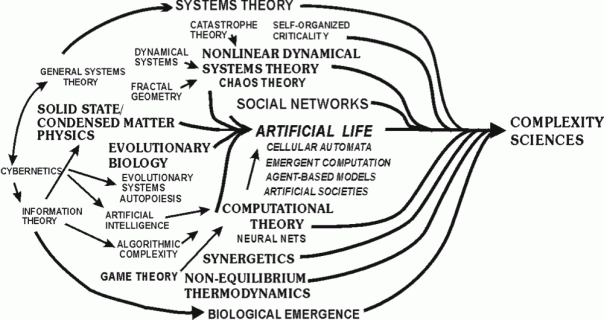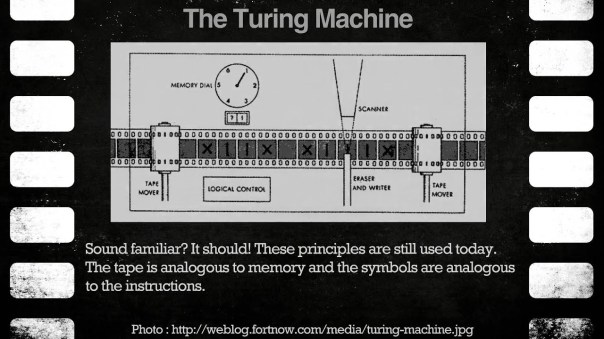Short History of Complexity
Posted by Hindol Datta
Complexity theory began in the 1930’s when natural scientists and mathematicians rallied together to get a deeper understanding of how systems emerge and plays out over time. However, the groundwork of complexity theory began in the 1850’s with Darwin’s introduction to Natural Selection. It was further extended by Mendel’s genetic algorithms. Darwin’s Theory of Evolution has been posited as a slow gradual process. He says that “Natural selection acts only by taking advantage of slight successive variations; she can never take a great and sudden leap, but must advance by short and sure, though slow steps.” Thus, he concluded that complex systems evolve by leaps and the result is an organic formulation of an irreducibly complex system which is composed of many parts, all of which work together closely for the overall system to function. If any part is missing or does not act as expected, then the system becomes unwieldy and breaks down. So it was an early foray into distinguishing the emergent property of a system from the elements that constitute it. Mendel, on the other hand, laid out the property of inheritance across generations. An organic system inherits certain traits that are reconfigured over time and adapts to the environment, thus leading to the development of an organism which for our purposes fall in the realm of a complex outcome. One would imagine that there is a common thread between Darwin’s Natural Selection and Mendel’s laws of genetic inheritance. But that is not the case and that has wide implications in complexity theory. Mendel focused on how the traits are carried across time: the mechanics which are largely determined by some probabilistic functions. The underlying theory of Mendel hinted at the possibility that a complex system is a result of discrete traits that are passed on while Darwin suggests that complexity arises due continuous random variations.

In the 1920’s, literature suggested that a complex system has elements of both: continuous adaptation and discrete inheritance that is hierarchical in nature. A group of biologists reconciled the theories into what is commonly known as the Modern Synthesis. The principles guiding Modern Synthesis were: Natural Selection was the major mechanism for evolutionary change. Small random variations of genes and natural selection result in the origin of new species. Furthermore, the new species might have properties different than the elements that constitute. Modern Synthesis thus provided the framework around Complexity theory. What does this great debate mean for our purposes? Once we arrive at determining whether a system is complex, then how does the debate shed more light into our understanding of complexity. Does this debate shed light into how we regard complexity and how we subsequently deal with it? We need to further extend our thinking by looking at a few new developments that occurred in the 20th century that would give us a better perspective. Let us then continue our journey into the evolution of the thinking around complexity.
Axioms are statements that are self-evident. It serves to be a premise or starting point for further reasoning and arguments. An axiom thus is not contestable because if it, then all the following reasoning that is extended against axioms would fall apart. Thus, for our purposes and our understanding of complexity theory – A complex system has an initial state that is irreducible physically or mathematically.
One of the key elements in Complexity is computation or computability. In the 1930’s, Turing introduced the abstract concept of the Turing machine. There is a lot of literature that goes into the specifics of how the machine works but that is beyond the scope of this book. However, there are key elements that can be gleaned from that concept to better understand complex systems. A complex system that evolves is a result of a finite number of steps that would solve a specific challenge. Although the concept has been applied in the boundaries of computational science, I am taking the liberty to apply this to emerging complex systems. Complexity classes help scientists categorize the problems based on how much time and space is required to solve problems and verify solutions. The complexity is thus a function of time and memory. This is a very important concept and we have radically simplified the concept to attend to a self-serving purpose: understand complexity and how to solve the grand challenges? Time complexity refers to the number of steps required to solve a problem. A complex system might not necessarily be the most efficient outcome but is nonetheless an outcome of a series of steps, backward and forward to result in a final state. There are pathways or efficient algorithms that are produced and the mechanical states to produce them are defined and known. Space complexity refers to how much memory that the algorithm depends on to solve the problem. Let us keep these concepts in mind as we round this all up into a more comprehensive work that we will relay at the end of this chapter.
Around the 1940’s, John von Neumann introduced the concept of self-replicating machines. Like Turing, Von Neumann’s would design an abstract machine which, when run, would replicate itself. The machine consists of three parts: a ‘blueprint’ for itself, a mechanism that can read any blueprint and construct the machine (sans blueprint) specified by that blueprint, and a ‘copy machine’ that can make copies of any blueprint. After the mechanism has been used to construct the machine specified by the blueprint, the copy machine is used to create a copy of that blueprint, and this copy is placed into the new machine, resulting in a working replication of the original machine. Some machines will do this backwards, copying the blueprint and then building a machine. The implications are significant. Can complex systems regenerate? Can they copy themselves and exhibit same behavior and attributes? Are emergent properties equivalent? Does history repeat itself or does it rhyme? How does this thinking move our understanding and operating template forward once we identify complex systems?

Let us step forward into the late 1960’s when John Conway started doing experiments extending the concept of the cellular automata. He introduced the concept of the Game of Life in 1970 as a result of his experiments. His main theses was simple : The game is a zero-player game, meaning that its evolution is determined by its initial state, requiring no further input. One interacts with the Game of Life by creating an initial configuration and observing how it evolves, or, for advanced players, by creating patterns with properties. The entire formulation was done on a two-dimensional universe in which patterns evolved over time. It is one of the finest examples in science of how a set of few simple non-arbitrary rules can result in an incredibly complex behavior that is fluid and provides a pleasing pattern over time. In other words, if one were an outsider looking in, you would see a pattern emerging from simple initial states and simple rules. We encourage you to look at several patterns that many people have constructed using different Game of Life parameters. The main elements are as follows. A square grid contains cells that are alive or dead. The behavior of each cell is dependent on the state of its eight immediate neighbors. Eight is an arbitrary number that Conway established to keep the model simple. These cells will strictly follow the rules.
Live Cells:
- A live cell with zero or one live neighbors will die
- A live cell with two or three live neighbors will remain alive
- A live cell with four or more live neighbors will die.
Dead Cells:
- A dead cell with exactly three live neighbors becomes alive
- In all other cases a dead cell will stay dead.
Thus, what his simulation led to is the determination that life is an example of emergence and self-organization. Complex patterns can emerge from the implementation of very simple rules. The game of life thus encourages the notion that “design” and “organization” can spontaneously emerge in the absence of a designer.
Stephen Wolfram introduced the concept of a Class 4 cellular automata of which the Rule of 110 is well known and widely studied. The Class 4 automata validates a lot of the thinking grounding complexity theory. He proves that certain patterns emerge from initial conditions that are not completely random or regular but seems to hint at an order and yet the order is not predictable. Applying a simple rule repetitively to the simplest possible starting point would bode the emergence of a system that is orderly and predictable: but that is far from the truth. The resultant state is that the results exhibit some randomness and yet produce patters with order and some intelligence.

Thus, his main conclusion from his discovery is that complexity does not have to beget complexity: simple forms following repetitive and deterministic rules can result in systems that exhibit complexity that is unexpected and unpredictable. However, he sidesteps the discussion around the level of complexity that his Class 4 automata generates. Does this determine or shed light on evolution, how human beings are formed, how cities evolve organically, how climate is impacted and how the universe undergoes change? One would argue that is not the case. However, if you take into account Darwin’s natural selection process, the Mendel’s law of selective genetics and its corresponding propitiation, the definitive steps proscribed by the Turing machine that captures time and memory, Von Neumann’s theory of machines able to replicate themselves without any guidance, and Conway’s force de tour in proving that initial conditions without any input can create intelligent systems – you essentially can start connecting the dots to arrive at a core conclusion: higher order systems can organically create itself from initial starting conditions naturally. They exhibit a collective intelligence which is outside the boundaries of precise prediction. In the previous chapter we discussed complexity and we introduced an element of subjective assessment to how we regard what is complex and the degree of complexity. Whether complexity falls in the realm of a first-person subjective phenomenon or a scientific third-party objective phenomenon has yet to be ascertained. Yet it is indisputable that the product of a complex system might be considered a live pattern of rules acting upon agents to cause some deterministic but random variation.
Posted on December 7, 2018, in Chaos, Complexity, Innovation, Learning Process, Model Thinking, Order, Organization Architecture, Social Dynamics. Bookmark the permalink. Comments Off on Short History of Complexity.
Comments are closed.